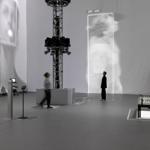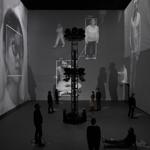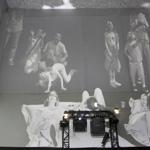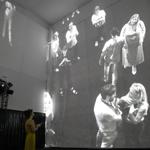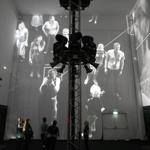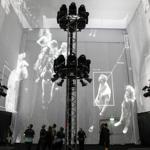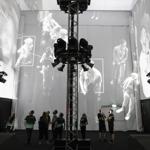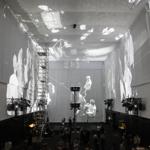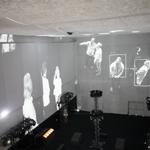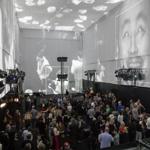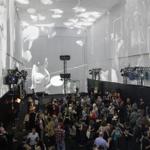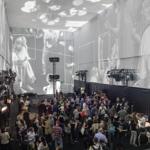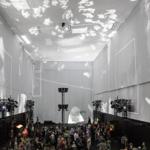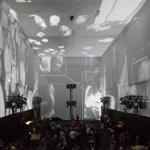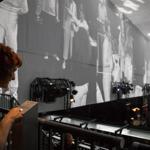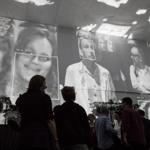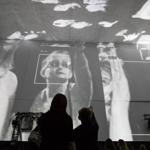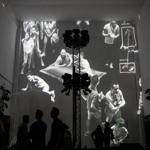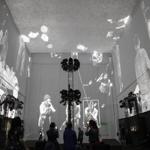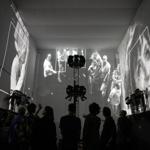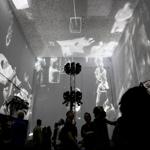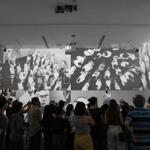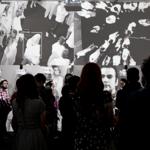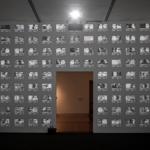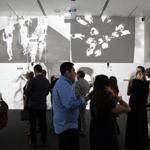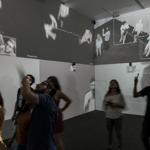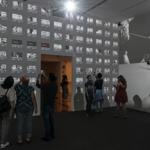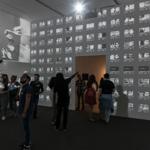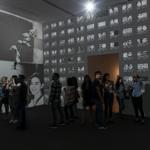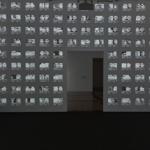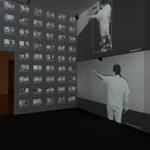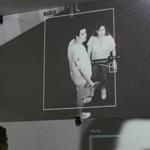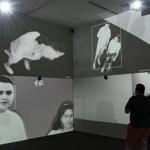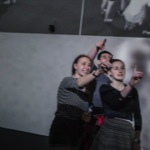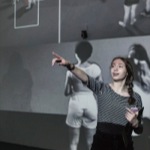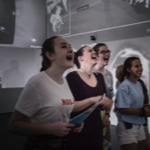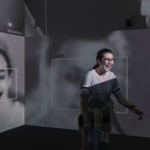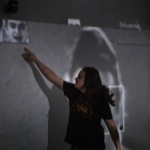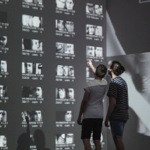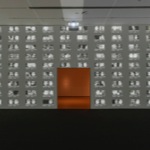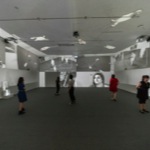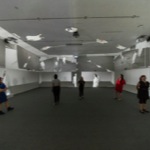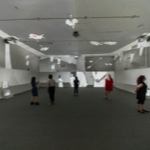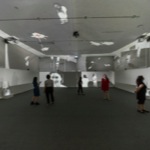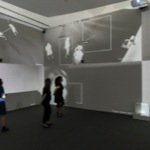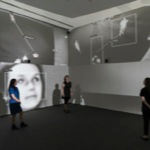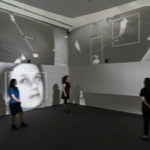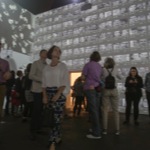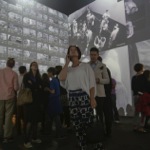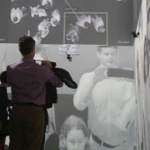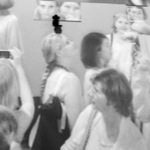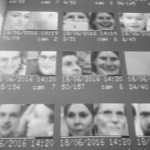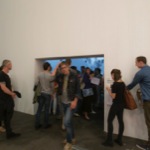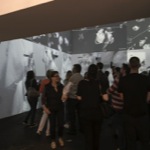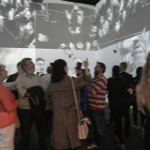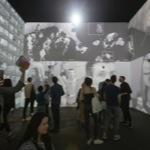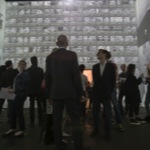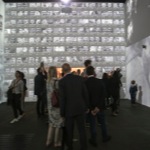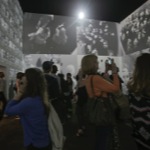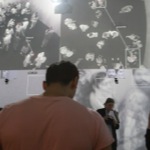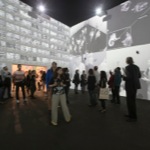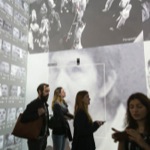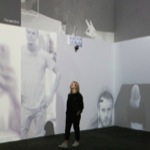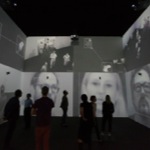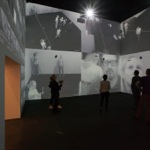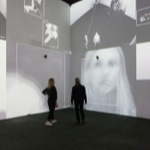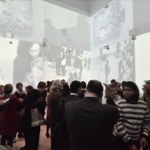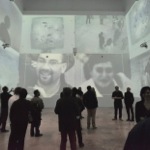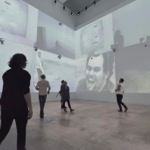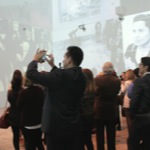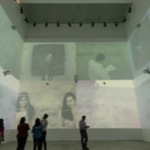Zoom Pavilion
Zoom Pavilion is an interactive installation that consists of immersive projection on three walls, fed by 12 computerized surveillance systems trained on the public. The piece uses face recognition algorithms to detect the presence of participants and record their spatial relationship within the exhibition space. Zoom Pavilion is at once an experimental platform for self-representation and a giant microscope to connect the public to each other and track their assembly. Independent robotic cameras zoom in to amplify the images of the public with up to 35x magnification: the zooming sequences are disorienting as they change the entire image "landscape" from easily recognizable wide shots of the crowd to abstract close-ups. The whole installation is in a fluid state of camera movement, highlighting different participants and creating a constantly changing animation based on optical amplification and tracking.
Zoom Pavilion marks the first collaboration between artists Rafael Lozano-Hemmer and Krzysztof Wodiczko. It was originally conceived for the Architecture Biennale in Beijing but only realized for Lozano-Hemmer’s current solo exhibition in Mexico City’s MUAC Museum. These artists' practice often involves transformation of an existing built environment using projection technologies to "augment" the site with alternative histories, connections or public relationships. The term "projection mapping" is now used often to describe techniques that Wodiczko was already deploying over 30 years ago. Meanwhile Lozano-Hemmer’s contribution to the field in the past 20 years has been to develop ways to make mapped projections interactive with the general public. This piece emphasizes the temporary construction of connective space in relation to predatory technologies of detection and control.
Zoom Pavilion marks the first collaboration between artists Rafael Lozano-Hemmer and Krzysztof Wodiczko. It was originally conceived for the Architecture Biennale in Beijing but only realized for Lozano-Hemmer’s current solo exhibition in Mexico City’s MUAC Museum. These artists' practice often involves transformation of an existing built environment using projection technologies to "augment" the site with alternative histories, connections or public relationships. The term "projection mapping" is now used often to describe techniques that Wodiczko was already deploying over 30 years ago. Meanwhile Lozano-Hemmer’s contribution to the field in the past 20 years has been to develop ways to make mapped projections interactive with the general public. This piece emphasizes the temporary construction of connective space in relation to predatory technologies of detection and control.
General info
Spanish name:
Pabellón de Ampliaciones
Year of creation:
2015
Technique:
Projectors, infrared cameras, computers, infrared illuminators, ethernet switch, HDMI and USB extenders
Power:
Typically consumes 4,000W on 110-220V, depending on the projectors
Room conditions:
Requires a darkened room without columns and room height should be at least 6m
Dimensions:
Variable screen size, at least 8m wide by 6m high
Keywords:
Edition:
3 Editions, 1 AP
Collectors:
private collector
Exhibitions
- Atmospheric Memory, Manchester International Festival, Powerhouse Ultimo - Museum of Applied Arts and Science, Sydney, Australia, 2023.
- Rafael Lozano-Hemmer: Atmospheric Memory, Manchester International Festival, University of North Carolina, Chapel Hill, North Carolina, United States, 2021.
- Shifting Proximities, Nxt Museum, Amsterdam, Netherlands, 2021 - 2022.
- La Tête dans le Nuage, Musée de la civilisation, Québec, Québec, Canada, 2019 - 2021.
- The Future and the Arts, Mori Art Museum, Tokyo, Japan, 2019 - 2020.
- Rafael Lozano-Hemmer: Presencia Inestable, Museo de Arte Contemporáneo de Monterrey, Monterrey, México, 2019 - 2020.
- Rafael Lozano-Hemmer: Atmospheric Memory, Manchester International Festival, Manchester, United Kingdom, 2019.
- Rafael Lozano-Hemmer: Présence instable, Musée d'art contemporain de Montréal, Montréal, Québec, Canada, 2018.
- Rafael Lozano-Hemmer: Decision Forest, Amorepacific Museum of Art, Seoul, South Korea, 2018.
- Future Shock, SITE Santa Fe, Santa Fe, New Mexico, United States, 2017 - 2018.
- From Selfie to Self-Expression, Saatchi Gallery, London, United Kingdom, 2017.
- Art Basel Unlimited - Art Basel 47, Gallerists collaboration (bitforms Gallery, Carroll / Fletcher Gallery, Galería Max Estrella and Wilde Gallery), Basel, Switzerland, 2016.
- Rafael Lozano-Hemmer: Pseudomatismos, Museo Universitario Arte Contemporáneo, Mexico City, México, 2015 - 2016.
Credits
- Programming: Stephan Schulz
- Production Assistance: Conroy Badger, Karine Charbonneau, Marc Lavallée, Guillaume Tremblay, Sergio Clavijo
Bibliography
- "Format observation: Zhou Chong Basel travel (on) wireless Unlimited." Collection Sina, 30 June 2016. Beijing, China, 2016. (chinese) (Websites)
- "Basel week Switzerland '16 / Recap: Unlimited." Arrested Motion, 22 June 2016. 2016. (english) (Websites)
- "Art Basel 16'dan Notlar." Artful Living, 20 June 2016. Istanbul, Turkey, 2016. (türkçe) (Websites)
- "Art Basel 2016: skyscrapers and spacemen - in pictures." The Guardian, 18 June 2016. London, United Kingdom, 2016. (english) (Newspapers)
- "Art Basel, una fiera e le sue emozioni: arte oltre il mercato." Ask A News, 16 June 2016. Rome, Italy, 2016. (italiano) (Websites)
- "A white house in Basel: Ai Wei Wei installation looms large at Swiss art event." Euronews, 16 June 2016. Lyon, France, 2016. (english) (Websites)
- "Comienza la 47 edición de Art Basel, el escaparate de arte más exigente." TVN Noticias, 16 June 2016. Panama City, Panama, 2016. (español) (Websites)
- "Five shows to see in Basel." Art Review, 14 June 2016. London, United Kingdom, 2016. (english) (Magazines)
- "Unlimited: Presenting 88 ambitious and large-scale works spanning six decades." Brooklyn Art Project, June 2016. New York City, New York, United States, 2016. (english) (Websites)
- "Lozano-Hemmer en Art Basel." La Tempestad, 16 May 2016. Mexico City, México, 2016. (español) (Magazines)
- "Unlimited: Presenting 88 ambitious and large-scale works spanning six decades." Artdaily, 29 Apr. 2016. Mexico City, México, 2016. (english) (Websites)
- "Rafael Lozano-Hemmer. Pseudomatismos." Kybernautas, 1 Mar. 2016. México, 2016. (español) (Websites)
- "Pseudomatismos: Rafael Lozano-Hemmer." L'enfer des arts, 3 Nov. 2015. México, 2015. (español) (Websites)
- "Rafael Lozano-Hemmer." ArtNexus, 27 Nov. 2015. Bogotá, Colombia, 2016. (english) (Magazines)
- "Rafael Lozano-Hemmer: Pseudomatisms." Digicult, 12 Nov. 2015. Milan, Italy, 2016. (english) (Websites)
- "Rafael Lozano-Hemmer | MUAC." W Insider, 11 Nov. 2015. Mexico City, México, 2016. (español) (Websites)
- "Pseudomatismos, de Rafael Lozano-Hemmer muestra la luz en el arte." Zona Franca, 30 Oct. 2015. San Miguel de Allende, México, 2015. (español) (Websites)
- "Pseudomatismos - Rafael Lozano-Hemmer." Lightroom, 27 Oct. 2015. Mexico City, México, 2015. (español) (Websites)
- "Pseudomatismos de Rafael Lozano-Hemmer." GASTV, Oct. 2015. México, 2015. (español) (Websites)
- Adys Safira, Karisma. "Kisah dari Art Basel 2016." Harper's Bazaar Indonesia, 2 July 2016. Jakarta, Indonesia, 2016. (bahasa indonesia) (Magazines)
- Akkermans, Ari. "Hints of the real world in Art Basel's elitist bubble." Hyperallergic, 22 June 2016. New York City, New York, United States, 2016. (english) (Websites)
- Bailey, Stephanie. "A blended mass: A report from Art Basel 2016." Ocula, 24 June 2016. Hong Kong, China, 2016. (english) (Magazines)
- Batty, David. "Art Basel: a dose of reality with exhibits on snooping and migration." The Guardian, 18 June 2016. London, United Kingdom, 2016. (english) (Newspapers)
- Bayley, Cameron. "New show may make you feel like you’re being watched. That’s because you are." The Sydney Morning Herald , 8 Aug. 2023. Sydney, Australia, 2023. (english) (Newspapers)
- Boyer, Guy. "Coup de cœur à la foire de Bâle 2016." Connaissance des Arts, 15 June 2016. Paris, France, 2016. (français) (Magazines)
- Chardon, Elisabeth. "Les gris sauvent Art Unlimited." Le Temps, 15 June 2016. Genève, Switzerland, 2016. (français) (Newspapers)
- Christie, Tom. "Art Basel: politics as unusual." Observer, 22 June 2016. New York City, New York, United States, 2016. (english) (Websites)
- Coscarelli, Dora. "Art|Basel 2016: Le Olimpiadi dell'Arte." Il Caffè Vitruviano Magazine, 25 June 2016. Italy, 2016. (italiano) (Websites)
- Dennis, Chris. "Art Basel Part 3 - Unlimited." Chris Dennis Art, 29 June 2016. 2016. (english) (Websites)
- De Rochebouët, Béatrice. "Ça c'est Bâle - Dîner de gala Unaids et concert de Duran Duran en ouverture d'Art Basel." Le Figaro, 15 June 2016. Paris, France, 2016. (français) (Newspapers)
- Egli, Jonas. "Voll, voller, Art Basel." barfi.ch, 16 June 2016. Basel, Switzerland, 2016. (deutsch) (Websites)
- Fino-Radin, Ben . "Digital preservations in the artist's studio." Medium, 29 Oct. 2015. San Francisco, California, United States, 2015. (english) (Websites)
- Forrest, Nicholas. "Art Basel names a record 88 projects for 2016 unlimited sector." Blouin ArtInfo, 28 Apr. 2016. New York City, New York, United States, 2016. (english) (Websites)
- Freeland, Anna. "Rafael Lozano-Hemmer’s Atmospheric Memory headlines Science Week at the Powerhouse with epic interactive exhibit for existential reflection." ABC News, 19 Aug. 2023. 2023. (english) (Newspapers)
- Freeman, Nate. "'Zoom Pavilion' at unlimited gives Art Basel a real-time look at surveillance." ART News, 17 June 2016. New York City, New York, United States, 2016. (english) (Magazines)
- Galindo, Gabriela. "Pseudomatismos y otras paranoias posmodernas. Reflexión sobre el trabajo de Rafael Lozano-Hemmer." Réplica 21, 2 Mar. 2016. Naucalpan, México, 2016. (español) (Websites)
- Gibson, Prudence and Edward Scheer. "The interactive art of Rafael Lozano-Hemmer: psychic resonance, surveillance and a murmuration of lights." The Conversation, 21 Aug. 2023. Canada, 2023. (english) (Magazines)
- Goldstein, Andrew M.. "The varieties of spectacular experience at Art Basel: Unlimited 2016." Art Space, 16 June 2016. New York City, New York, United States, 2016. (Websites)
- Gómez, Jocelyn. "Rafael Lozano-Hemmer expone Pseudomatismos en Ciudad de México." Designboom, 14 Nov. 2015. Milan, Italy, 2016. (español) (Websites)
- Heim, Christoph. "Magie der Überwachung." Basler Zeitung, 4 July 2016. Basel, Switzerland, 2016. (Newspapers)
- Henkes, Alice. "Der diskrete Charme der grossen Kunst - an der Art Basel." SRF, 15 June 2016. Switzerland, 2016. (deutsch) (Websites)
- Huerta, J.F.. "Rafael Lozano-Hemmer | Pseudomatismos." ARTINDF, 14 Jan. 2016. Mexico City, México, 2016. (Websites)
- J.-J.R.. "Que vont faire les pros de l'art à la foire d'Art Basel?." Le Matin Dimanche, 12 June 2016. Lausanne, Switzerland, 2016. (français) (Magazines)
- Johnson, Kimberly B.. "This exhibit uses computerized surveillance as art." PSFK, 14 June 2016. New York City, New York, United States, 2016. (english) (Websites)
- Karich, Swantje. "Schlüssel zum Erfolg." Welt N24, 18 June 2016. Berlin, Germany, 2016. (deutsch) (Newspapers)
- Lempesis, Dimitris. "Art fairs: Art Basel 2016-Unlimited, Part I." Dream Idea Machine, 2016. 2016. (english) (Websites)
- Libertad, Julia. "Pseudomatismos in Mexico. An interview with Rafael Lozano-Hemmer." Happening, 30 Oct. 2015. Mexico City, México, 2015. (english) (Websites)
- Lomeli, Natty. "Obras colectivas, cuando la participación crea arte." Cultura Colectiva, 7 Mar. 2016. Mexico City, México, 2016. (español) (Websites)
- Matroos, Jaime. "The exhibit that turns audience into art." Design Indaba, 15 June 2016. Cape Town, South Africa, 2016. (english) (Websites)
- Miles, Ned Carter. "Digitalised Reflections." Aesthetica, 8 Apr. 2017. York, United Kingdom, 2017. (english) (Magazines)
- Miller, Meg. "In the 21st century, even the art is watching you." Fast Company - Design, 10 June 2016. New York City, New York, United States, 2016. (english) (Websites)
- Moncada, Futuro. "Pseudomatismos de Rafael Lozano-Hemmer. Un texto de futuro Moncada." Circulo A, 8 Jan. 2016. México, 2016. (español) (Websites)
- Morales Ortigoza, Guadalupe Viridiana. "Pseudomatismos: Cuando la tecnología se vuelve arte." Aunam Noticias, 28 Nov. 2015. Mexico City, México, 2016. (español) (Websites)
- Nesvet, Nancy. "Social justice artist, practitioner of interrogative design and Harvard professor Krzysztof Wodiczko." Artscope, 2 Mar. 2017. Quincy, Massachusetts, United States, 2017. (english) (Magazines)
- Önol, Isin. "Rafael Lozano-Hemmer ve Kolektif Bellek." Artful Living, 28 July 2016. Istanbul, Turkey, 2016. (türkçe) (Websites)
- Palapa Quijas, Fabiola. "Interactividad lúdica llega a más de 260 mil espectadores." La Jornada, 17 Apr. 2016. Mexico City, México, 2016. (español) (Newspapers)
- Palapa Quijas, Fabiola. "Muestra Rafael Lozano-Hemmer relación entre máquina, entorno y percepción." La Jornada, 27 Oct. 2015. Mexico City, México, 2015. (español) (Newspapers)
- Pangburn, DJ. "Pseudomatisms exhibition finds patterns in the randomness." The Creators Project, 12 Nov. 2015. New York City, New York, United States, 2016. (english) (Websites)
- Perez Diez, Gustavo. "Los 10 artistas mexicanos con mayor presencia internacional." Arteinformado, 20 June 2016. Madrid, Spain, 2016. (español) (Magazines)
- Pirovano, Stefano. "Art Basel 2016: a positive reaction to the impossible Brexit." Conceptual Fine Arts, 15 June 2016. 2016. (english) (Websites)
- Ravasi, Marta. "Art Basel 2016 | Unlimited." ATP Diary, 26 June 2016. Italy, 2016. (italiano) (Websites)
- Roffiel, Othiana. "Art Basel. La estética de la resistencia." Artishock, 28 June 2016. Chile, 2016. (español) (Websites)
- Roffiel, Othiana. "Rafael Lozano-Hemmer. Cuando el retrato se convierte en paisaje." Artishock, 21 June 2016. Chile, 2016. (español) (Websites)
- Roffiel, Othiana. "Calculating uncertainty - A conversation with Rafael Lozano-Hemmer." Art Pulse, 2016. United States, 2016. (english) (Magazines)
- Rylan, Ben and Jane Morris. "Art Basel." The Monocle Art Review, 20 June 2016. London, United Kingdom, 2016. (english) (Magazines)
- Sansom, Anna. "Unlimited at Art Basel." Damn Magazine, July 2016. Ghent, Belgium, 2016. (english) (Magazines)
- Sierra, Sonia. "'Ahora son las obras las que miran al publico': Rafael Lozano-Hemmer." Confabulario - El Universal, 2 Jan. 2016. Mexico City, México, 2016. (español) (Newspapers)
- Sterling, Bruce. "Rafael Lozano-Hemmer at the San Francisco MoMA." Wired, 12 Jan. 2020. (english) (Websites)
- Stübi, Corine. "Art Unlimited 2016." Espaces Contemporains, 17 June 2016. Puidoux, Switzerland, 2016. (français) (Magazines)
- Suárez, Eunice . "Rafael Lozano-Hemmer llega al MUAC." Fahrenheit, 5 Nov. 2015. Mexico City, México, 2016. (español) (Magazines)
- Uribe, Daniela. "Respiración y latidos convertidos en piezas de arte, en la obra de Rafael Lozano-Hemmer." Arte y Cultura, 4 Nov. 2015. México, 2015. (español) (Websites)
Photo Library (click to expand)
